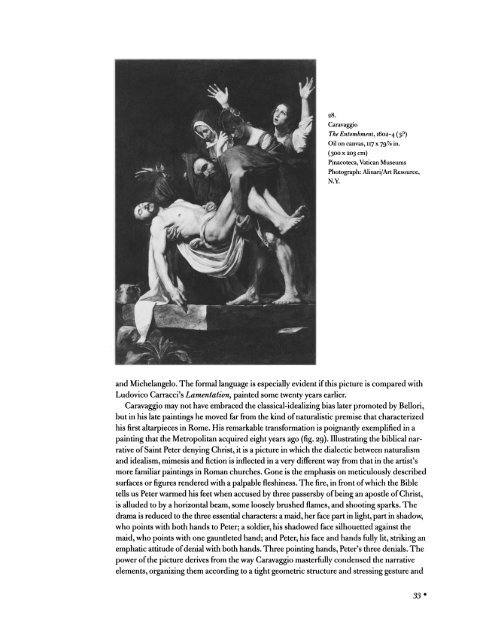GOING FOR BAROQUE Into the Bin - The Metropolitan Museum of Art
GOING FOR BAROQUE Into the Bin - The Metropolitan Museum of Art
GOING FOR BAROQUE Into the Bin - The Metropolitan Museum of Art
You also want an ePaper? Increase the reach of your titles
YUMPU automatically turns print PDFs into web optimized ePapers that Google loves.
28.<br />
Caravaggio<br />
<strong>The</strong> Entombment, 1602-4 (3?)<br />
Oil on canvas, 117 x 79% in.<br />
x<br />
(300 203 cm)<br />
Pinacoteca, Vatican <strong>Museum</strong>s<br />
Photograph: Alinari/<strong>Art</strong> Resource,<br />
N.Y.<br />
and Michelangelo.<br />
<strong>The</strong> formal<br />
language<br />
is especially<br />
evident if this picture<br />
is compared with<br />
Ludovico Carracci's Lamentation, some<br />
painted twenty years earlier.<br />
Caravaggio may<br />
not have embraced <strong>the</strong> classical-idealizing<br />
bias later promoted by Bellori,<br />
but in his late paintings<br />
he moved far from <strong>the</strong> kind <strong>of</strong> naturalistic premise that characterized<br />
his first altarpieces<br />
in Rome. His remarkable transformation is poignantly exemplified<br />
in a<br />
painting<br />
that <strong>the</strong> <strong>Metropolitan</strong> acquired eight years ago (fig. 29). Illustrating<br />
<strong>the</strong> biblical nar<br />
rative <strong>of</strong> Saint Peter<br />
denying Christ, it is a picture<br />
in which <strong>the</strong> dialectic between naturalism<br />
and idealism, mimesis and fiction is inflected in a very different way from that in <strong>the</strong> artist's<br />
more familiar<br />
paintings<br />
in Roman churches. Gone is <strong>the</strong> on emphasis meticulously<br />
described<br />
surfaces or figures<br />
rendered with a palpable fleshiness. <strong>The</strong> fire, in front <strong>of</strong> which <strong>the</strong> Bible<br />
tells us Peter warmed his feet when accused<br />
by<br />
three passersby<br />
<strong>of</strong> an being apostle<br />
<strong>of</strong> Christ,<br />
is alluded to a by<br />
horizontal beam,<br />
some<br />
loosely<br />
brushed flames, and<br />
shooting sparks. <strong>The</strong><br />
drama is reduced to <strong>the</strong> three essential characters: a maid, her face part in light, part in shadow,<br />
who<br />
points with both hands to Peter; a soldier, his shadowed face silhouetted<br />
against<br />
<strong>the</strong><br />
maid, who<br />
points<br />
with one<br />
gauntleted hand; and Peter, his face and hands<br />
fully lit,<br />
an<br />
striking<br />
emphatic attitude <strong>of</strong> denial with both hands. Three<br />
pointing hands, Peter's three denials. <strong>The</strong><br />
power <strong>of</strong> <strong>the</strong> picture<br />
derives from <strong>the</strong> way Caravaggio masterfully<br />
condensed <strong>the</strong> narrative<br />
elements,<br />
organizing<br />
<strong>the</strong>m according<br />
to a tight geometric<br />
structure and<br />
stressing gesture and<br />
33
















